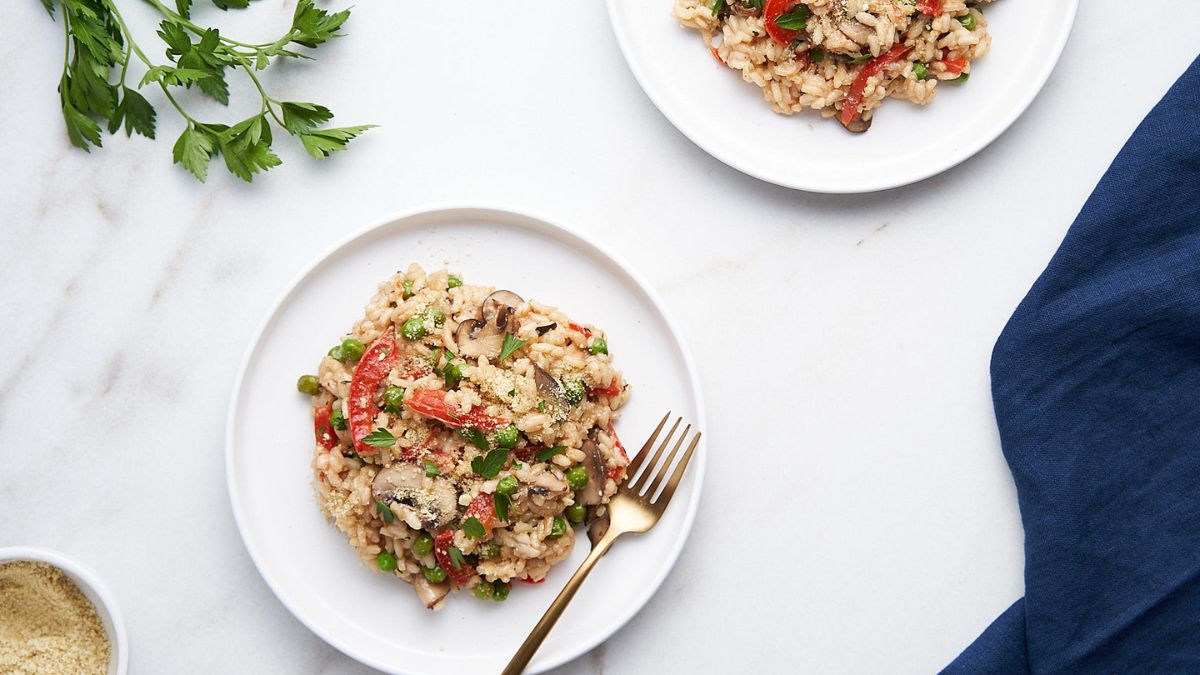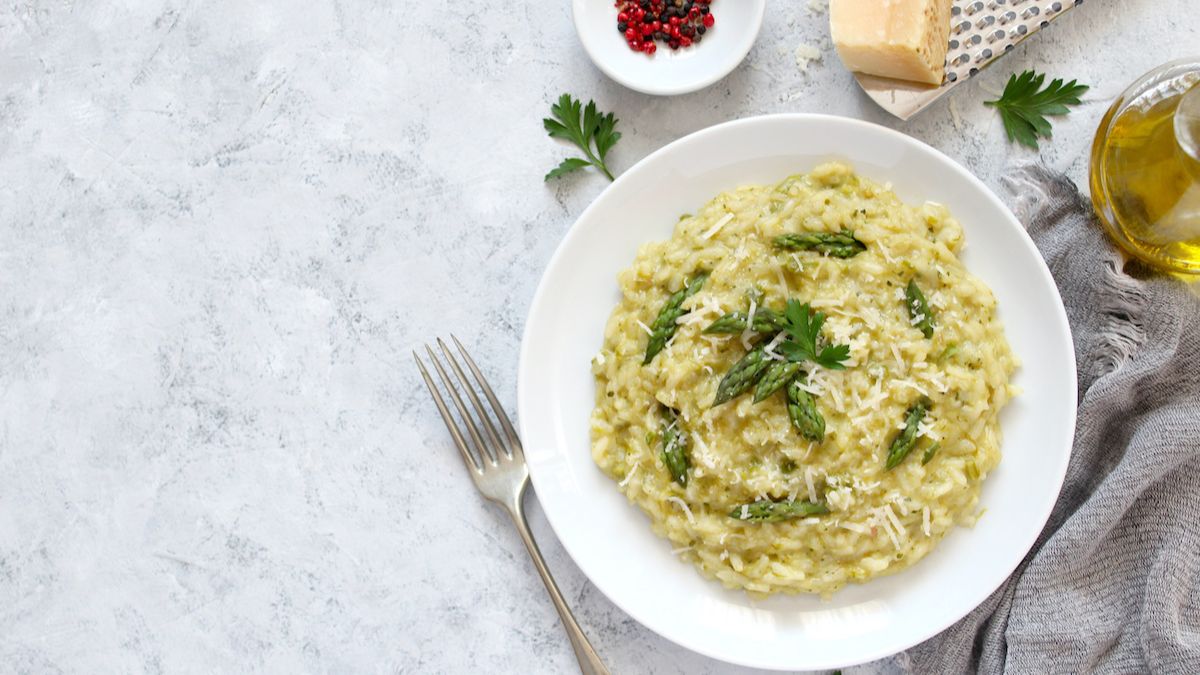Italian cuisine, risotto, is made of creamy rice cooked in broth. Italian cuisine known as risotto is prepared by simmering starchy, short-grain rice, such as arborio, with stock until it becomes creamy. White wine, onion, and Parmesan cheese are also often used in traditional risotto. With additional ingredients like mushrooms or a protein of your choice.
When choosing which ones to use, choose veggies with various hues, such as broccoli, red peppers, sweet potatoes, and red onions. Please put them in the oven to roast and season with salt and pepper after drizzling them with olive oil. This wonderful risotto side may be made with just that.
What is Risotto?
Italian cuisine known as risotto is prepared by simmering starchy, short-grain rice, such as arborio, with stock until it becomes creamy. There is a lot of focus on the cooking method because there are so few ingredients: slowly ladling heated liquid into a skillet full of rice, stirring until the stock is absorbed, ladling in more stock, and repeating.
However, the rice may be a neutral background to anything you have on hand in the fridge, whether it’s a little bit of leftover bacon or some stunning fresh green peas. Risotto should spread out into a velvety, spoonable pool when served. The meal is frequently completed with butter and freshly grated Parmesan to kick up the creamy flavor.
What are the Different Types of Vegetables Risotto?
- Vegetarian foods go well with the risotto. Italian vegetable dishes like mushroom and spring vegetable risotto sometimes include arborio rice, wine, and a variety of vegetables, including asparagus and mushrooms. Many other taste combinations can be used to make risotto, such as roast pumpkin with feta.
- A typical vegetable ingredient in risotto is mushroom. Asparagus, shallots, and mushrooms are used in the mushroom and spring vegetable risotto. Arborio rice from the recipe receives flavoring from dry vermouth, fresh thyme, and freshly squeezed lemon juice. Crimini mushrooms, dried mushrooms like morels or black trumpets, and wild mushrooms like chanterelles, hedgehogs, or pleurote are all used in wild mushroom risotto. The Gorgonzola and wild mushroom risotto ingredients include crumbled Gorgonzola cheese, dried chanterelle mushrooms, and button mushrooms.
- Asparagus is used to flavor a variety of vegetable meals. Asparagus, leeks, and peas are used in springtime green risotto. Spinach, chopped basil leaves, and flat-leaf parsley are included in the green risotto. White wine, Parmesan cheese, and chopped onion are all ingredients in risotto with asparagus. Onions, wild mushrooms, and asparagus are all in risotto with those flavors. Asparagus, peas, and young spinach leaves are added to the dish.
- Another often used element in risotto meals made with vegetables is broccoli. Broccoli florets, garlic, and finely chopped fresh chives are included in the broccoli risotto with cream and lemon. The emerald green risotto includes celery, sugar snap peas, and broccoli florets. Zucchini, fresh green beans, and chopped fresh parsley are some other veggies included in the recipe.
- Parmesan cheese adds taste to many risotto meals made with vegetables as the base. Cubed butternut squash, dry white wine, and grated Parmesan cheese are the main ingredients in butternut squash risotto. White wine, Parmesan cheese, and garlic powder flavor the tomato, corn, and basil risotto. With onion, white wine, and Reggiano Parmesan cheese as the flavorings, green risotto with fava beans is prepared.
- You may also use pumpkin, artichokes, and zucchini to make vegetable risotto. Mashable pumpkin, young spinach leaves, and feta cheese are roast pumpkin and feta risotto ingredients. Sun-dried tomatoes, fresh basil leaves, and thinly sliced zucchini are ingredients in zucchini risotto. Fresh mint, artichokes, lemon zest, and juice are all ingredients in artichoke risotto.
- Pumpkin, artichokes, and zucchini can also make vegetable risotto. The dish “Roasted Pumpkin and Feta Risotto” includes mashed pumpkin, baby spinach leaves, and feta cheese. Zucchini, sun-dried tomatoes and fresh basil leaves are all included in the zucchini risotto. A lemon’s zest and juice are added to artichoke risotto and fresh mint.
How Many Different Types of Risotto are there?
Arborio, Baldo, Carnaroli, Maratelli, Padano, Roma, and Vialone Nano are the main kinds grown in Italy. The greatest (and most expensive) types are thought to be Carnaroli, Maratelli (an old Italian variety), and Vialone Nano, with many users favoring one over the other.
How to Make Mushroom and Spring Vegetable Risotto?
Ingredients
- 4 ounces pencil-thin asparagus
- 7 cups water
- Three teaspoons of kosher salt, plus two teaspoons of water
- Freshly ground black pepper
- 1/2 cup unsalted butter
- 8 ounces mixed mushrooms, sliced
- One shallot, diced
- 1 1/2 cups Arborio rice
- 1/2 cup dry vermouth
- 3 to 4 generous sprigs of fresh thyme or lemon thyme
- 1 to 2 teaspoons finely grated lemon zest
- 1/2 cup grated parmesan cheese
- 5 ounces (1 cup) of frozen peas, thawed
- Two tablespoons of freshly squeezed lemon juice
Directions
- Cut the asparagus below the tips at 1/4-inch intervals on an angle, eliminating the bottom woody portion. Place aside.
- Two teaspoons of salt are added to simmering water. Maintain a gentle simmer.
- Mushrooms are added to a large skillet heated to medium-high heat with two tablespoons of butter. Cook until crispy and golden, stirring periodically. To taste, add 1/2 teaspoon each of salt and pepper and leave aside.
- Another two tablespoons of the butter should be added to a sizable saucepan and heated to a nutty color over medium-high heat. The shallot should be added to the pot and cooked for 2 minutes or until transparent. For approximately a minute, add the rice and toss until it is shiny and covered in butter. Add the remaining 2 1/2 tablespoons of salt and stir. When the rice has absorbed all the vermouths, add more and continue cooking while tossing with a wooden spoon. Spring thyme should be added. To make the rice absorb the liquid again, add about 1/2 cup of the simmering water and stir regularly while adjusting the heat to maintain a soft simmer. Ladle in water in increments of approximately 1/2 cup, stirring in between, and letting the rice soak it up before adding more.
- Stir in lemon zest after the rice has cooked for about 10 minutes when it has absorbed roughly half the water—five more minutes of churning and water addition. Include asparagus. After 20 minutes of cooking, when the rice is soft but still al dente, cease adding water. Add the remaining butter and cheese and mix well. Just until cooked through, add the mushrooms, peas, and lemon juice. Get rid of the heat. Before serving, give the risotto a little moment of rest. Divide among four heated bowls, generously sprinkle with pepper, and then serve.
What does Risotto Taste Like?
Famously creamy in flavor, risotto. Similar to rice-based mac and cheese, risotto is a creamy Italian delicacy. In contrast to other rice dishes that call for simmering in a pot of water, risotto is prepared by gradually adding little amounts of liquid. This is so because it’s typically made with non-vegan components, including butter, cheese, and occasionally cream. But risotto has a flavor that goes beyond being merely “creamy.” Onions can give it sweetness, while mushrooms and vegetable stock can give it an earthy flavor (watch out for risottos made with chicken stock). It’s frequently seasoned with zingy herbs like thyme and parsley.
How to Store Leftover Risotto?
- Risotto leftovers should be stored in the refrigerator.
- When keeping food, especially rice dishes, remember that they take up a lot of fridge space and necessitate airtight containers or bags covered with aluminum foil as an additional safety measure.
- Never leave fresh ingredients out on the counter.
- Risotto leftovers can be stored in the refrigerator for up to five days, after which they should either be frozen or thrown away.
- As an alternative, the risotto can be stored for up to four months in an airtight container or plastic bag.
- Take leftovers out of the fridge and leave them on the counter until it is safe to reheat them in the microwave.
- Choosing what to do with the risotto that is left over is difficult.
- There are numerous ways to use up leftover risotto.
- You can include vegetables and mushrooms to make an intriguing stir-fry dish.
- For a simple pilaf, combine it with grains like farro and roasted veggies.
Conclusion
Rice is heavy in carbs, even though rice pilaf, risotto, fried rice, steamed rice, rice casseroles and soups, and other rice meals may taste nice and be filling. Try cajun honey butter salmon, seared scallops, and crispy soy tofu for additional protein choices. The ideal side dishes with mushroom risotto are spinach salad, shrimp scampi, pan-seared steaks, and baked chicken thighs.
Serve garlic bread or a sausage and pepper tray bake as additional options. Consuming an abundance of high-glycemic foods might worsen insulin resistance and make it more difficult to manage your blood sugar levels. According to cooks and fans of the dish, the ideal rice for risotto has similar characteristics: it should be fat, short- or medium-grained, and contain a lot of amylopectin or starch to make it sturdy enough to withstand stirring.
Some of the more well-known types of rice that you can use are bomba, which is short-grained and typically used to make a Spanish paella; arborio, which tends to turn mushy rather quickly and can produce a rather thick sauce; and carnaroli, which manages to maintain its shape while still delivering on the creamy aspect.

